从Java反序列化漏洞题看CodeQL数据流
前言
本次实验项目源码来源之前我写的Shiro-CTF的源码https://github.com/SummerSec/JavaLearnVulnerability/tree/master/shiro/shiro-ctf ,项目需要database文件上传到GitHub项目 learning-codeql上。
本文的漏洞分析文章一道shiro反序列化题目引发的思考 ,看本文之前看完这漏洞分析会更好的理解。但本文会从全新的角度去挖掘审计漏洞,但难免会有之前既定思维。如果你有兴趣和我一起交流学习CodeQL可以联系summersec#qq.com。
找到可以序列化的类
挖掘反序列化漏洞,首先得找到入口。可以反序列化的类首先肯定是实现了接口Serializable,其次会有一个字段serialVersionUID,所以我们可以从找字段或者找实现接口Serializable入手进行代码分析。
-
TypeSerializable类,在JDK中声明 -
instanceof断言 -
fromSource谓词判断来着项目代码排除JDK自带 -
getASupertype递归,父类类型
import java
/*找到可以序列化类,实现了Serializable接口 */
from Class cl
where
cl.getASupertype() instanceof TypeSerializable
/* 递归判断类是不是实现Serializable接口*/
and
cl.fromSource()
/* 限制来源 */
select cl
/* 查询语句 */
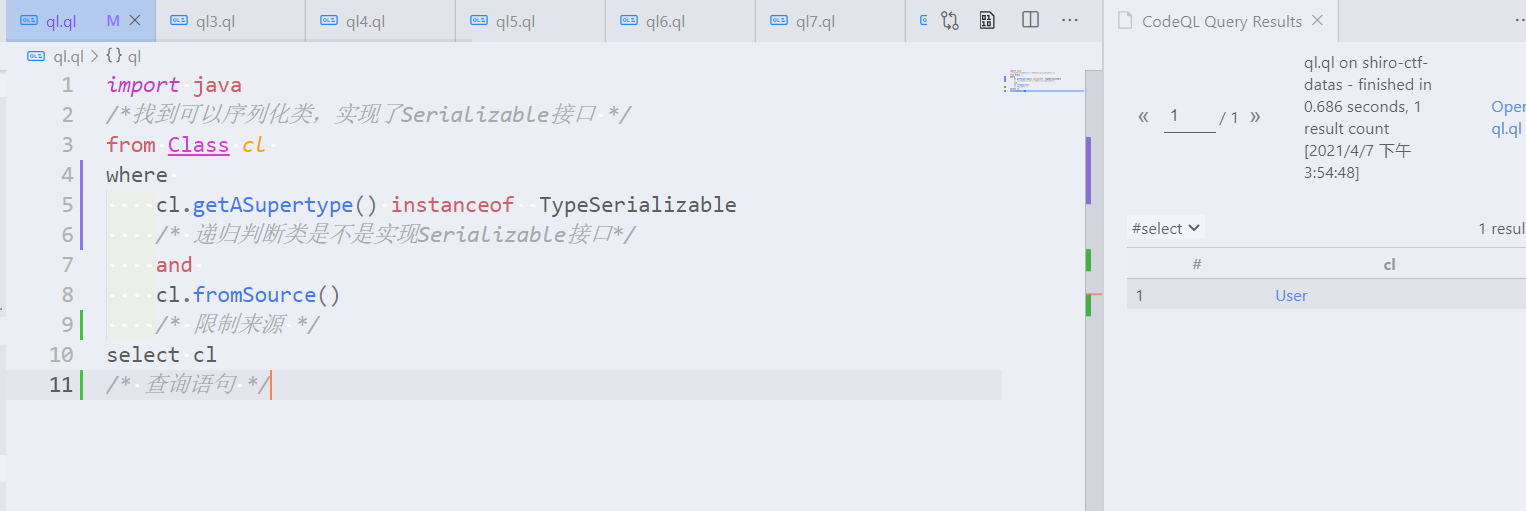
点击查询出来的结果可以看到对应的查询结果源码

找User类实例化代码
使用RefType.hasQualifiedName(string packageName, string className)来识别具有给定包名和类名的类,这里使用一个类继承RefType,使代码可读性更高点。例如下面两端QL代码是等效的:
import java
from RefType r
where r.hasQualifiedName("com.summersec.shiroctf.bean", "User")
select r
import java
/* 找到实例化User的类 */
class MyUser extends RefType{
MyUser(){
this.hasQualifiedName("com.summersec.shiroctf.bean", "User")
}
}
from ClassInstanceExpr clie
where
clie.getType() instanceof MyUser
select clie
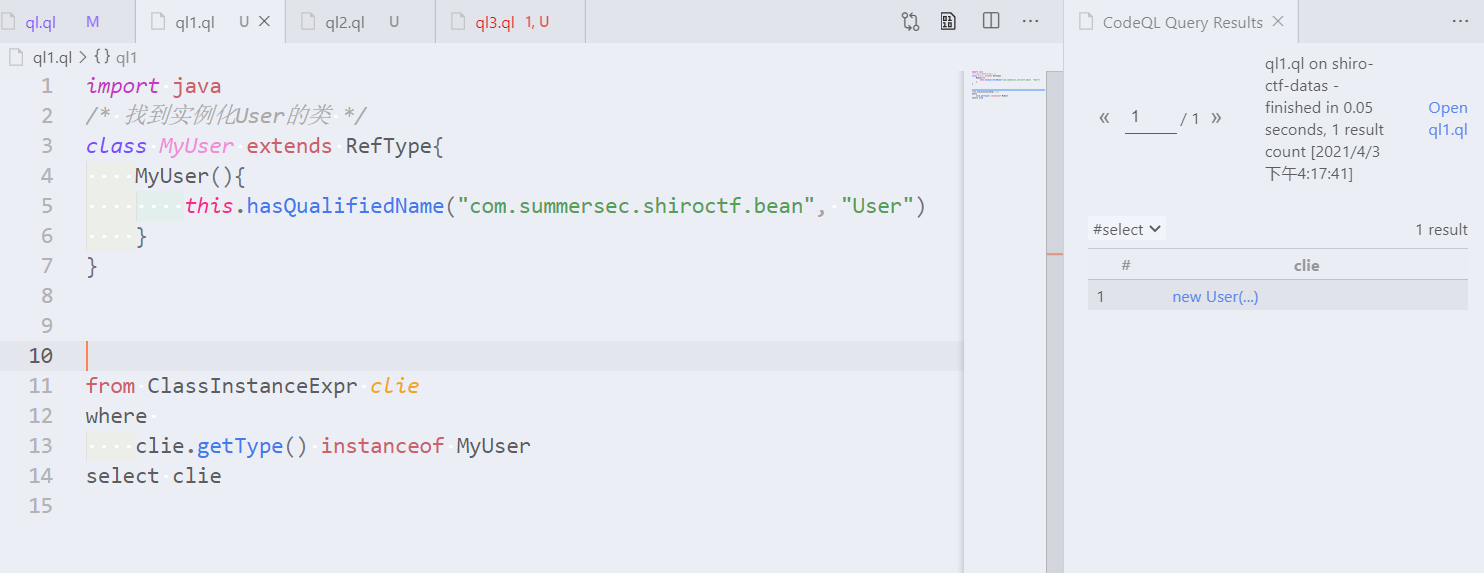
可以发现在IndexController类59行处实例化User类。

IndexController:
package com.summersec.shiroctf.controller;
import javax.servlet.http.Cookie;
import javax.servlet.http.HttpServletRequest;
import javax.servlet.http.HttpServletResponse;
import com.summersec.shiroctf.Tools.LogHandler;
import com.summersec.shiroctf.Tools.Tools;
import com.summersec.shiroctf.bean.User;
import org.springframework.stereotype.Controller;
import org.springframework.web.bind.annotation.GetMapping;
import org.springframework.web.bind.annotation.PathVariable;
@Controller
public class IndexController {
public IndexController() {
}
@GetMapping({"/"})
public String main() {
return "redirect:login";
}
@GetMapping({"/index/{name}"})
public String index(HttpServletRequest request, HttpServletResponse response, @PathVariable String name) throws Exception {
Cookie[] cookies = request.getCookies();
boolean exist = false;
Cookie cookie = null;
User user = null;
if (cookies != null) {
Cookie[] var8 = cookies;
int var9 = cookies.length;
for(int var10 = 0; var10 < var9; ++var10) {
Cookie c = var8[var10];
if (c.getName().equals("hacker")) {
exist = true;
cookie = c;
break;
}
}
}
if (exist) {
byte[] bytes = Tools.base64Decode(cookie.getValue());
user = (User)Tools.deserialize(bytes);
} else {
user = new User();
user.setID(1);
user.setUserName(name);
cookie = new Cookie("hacker", Tools.base64Encode(Tools.serialize(user)));
response.addCookie(cookie);
}
request.setAttribute("hacker", user);
request.setAttribute("logs", new LogHandler());
return "index";
}
}
查看Tools类源码是否存在问题
查看源码有Base64编码解码函数、序列化、反序列化以及exeCmd方法,该函数可以执行命令
对于Tools#deserialize方法可以编写规则:
import java
class Deserialize extends RefType{
Deserialize(){
this.hasQualifiedName("com.summersec.shiroctf.Tools", "Tools")
}
}
class DeserializeTobytes extends Method{
DeserializeTobytes(){
this.getDeclaringType() instanceof Deserialize
and
this.hasName("deserialize")
}
}
from DeserializeTobytes des
select des
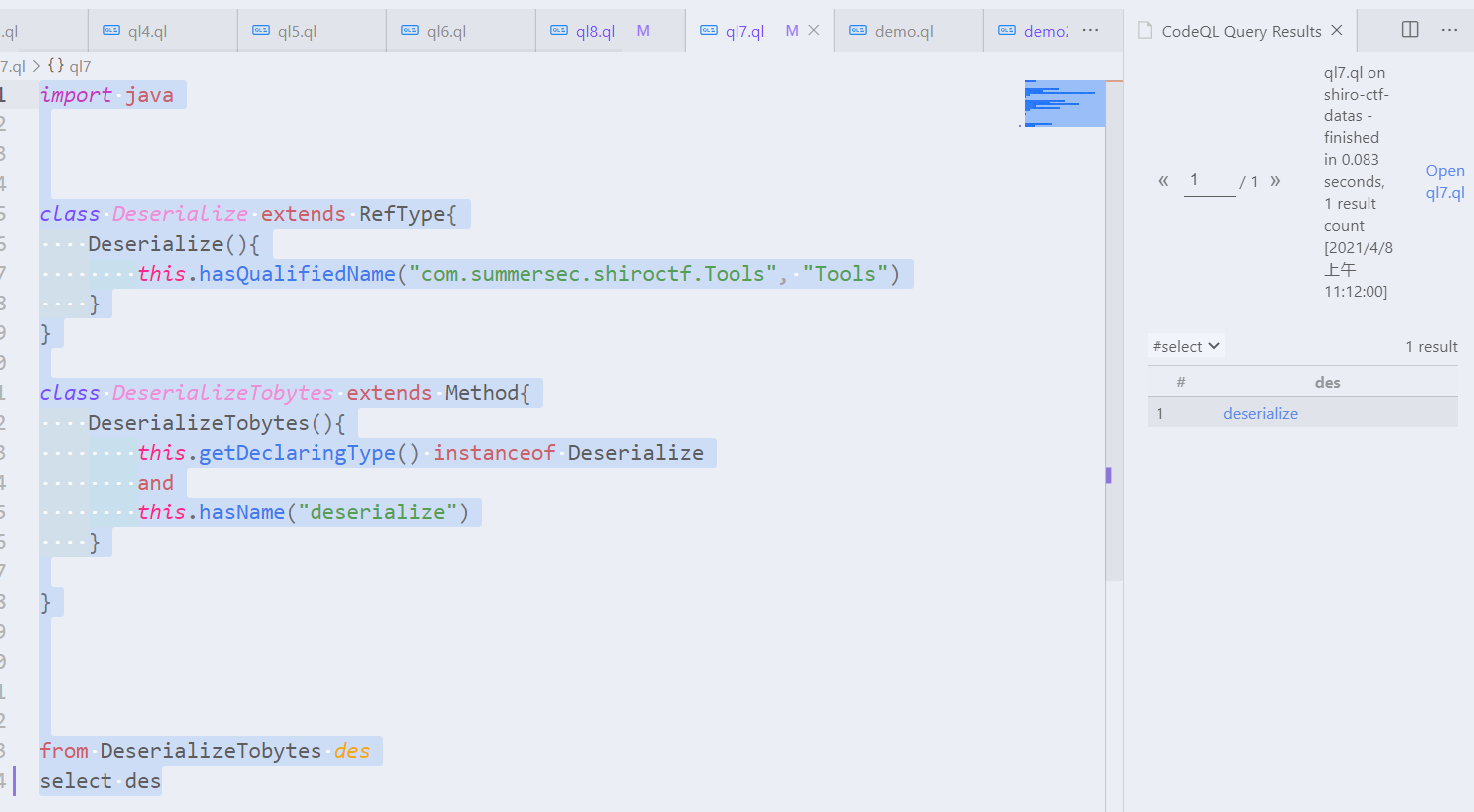
对于Tools#exeCmd方法的调用可以找到,可以发现LogHandler类调用了两次exeCmd方法。
import java
/* 找到调用exeCmd方法 */
from MethodAccess exeCmd
where exeCmd.getMethod().hasName("exeCmd")
select exeCmd


下面是exeCmd方法的源码,不能发现可以执行任何命令,传入的参数commandStr即是将被执行的命令。
public static String exeCmd(String commandStr) {
BufferedReader br = null;
String OS = System.getProperty("os.name").toLowerCase();
try {
Process p = null;
if (OS.startsWith("win")){
p = Runtime.getRuntime().exec(new String[]{"cmd", "/c", commandStr});
}else {
p = Runtime.getRuntime().exec(new String[]{"/bin/bash", "-c", commandStr});
}
br = new BufferedReader(new InputStreamReader(p.getInputStream()));
String line = null;
StringBuilder sb = new StringBuilder();
while((line = br.readLine()) != null) {
sb.append(line + "\n");
}
return sb.toString();
} catch (Exception var5) {
var5.printStackTrace();
return "error";
}
}
精简代码逻辑
对IndexController简单提炼处理逻辑,画出数据流流程图:
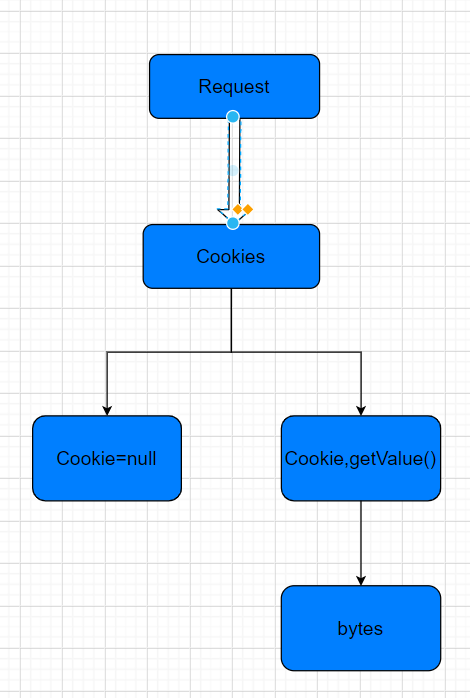
HttpServletRequest request = null
Cookie[] cookies = request.getCookies();
Cookie cookie = c
byte[] bytes = Tools.base64Decode(cookie.getValue());
user = (User)Tools.deserialize(bytes);
目前就有以下几点:
request和bytes是有联系的- 预期是将
request作为source,sink是deserialize()#bytes Tools#exeCmd方法肯定是可以被利用的Loghandler类的目的?
污点分析
污点分析简单介绍
现在已经确定了(a)程序中接收不受信任数据的地方和(b)程序中可能执行不安全的反序列化的地方。现在把这两个地方联系起来:未受信任的数据是否流向潜在的不安全的反序列化调用?在程序分析中,我们称之为数据流问题。数据流作用:这个表达式是否持有一个源程序中某一特定地方的值呢?
污点分析是一种跟踪并分析污点信息在程序中流动的技术。在漏洞分析中,使用污点分析技术将所感兴趣的数据(通常来自程序的外部输入)标记为污点数据,然后通过跟踪和污点数据相关的信息的流向,可以知道它们是否会影响某些关键的程序操作,进而挖掘程序漏洞。
在CodeQL提供了数据流分析的模块,分为全局数据流、本地数据流、远程数据流。数据流分析有一般有以下几点:
-
source定义污染数据即污点 sink判断污点数据流出sanitizers对数据流判断无害处理(可选)additionalTaintStepCodeQL增加判断污染额外步骤(可选)
Example:
int func(int tainted) {
int x = tainted;
if (someCondition) {
int y = x;
callFoo(y);
} else {
return x;
}
return -1;
}
上面的方法的数据流图是下面这样子,这个图表示污点参数的数据流。图的节点代表有值的程序元素,如函数参数和表达式。该图的边代表流经这些节点的流量。变量 y 的取值依赖于变量 x 的取值,如果变量 x 是污染的,那么变量 y 也应该是污染的。

更多学习资料:
污点分析简单介绍 对污点分析做了详细的介绍
CodeQL-数据流在Java中的使用 百度某大佬对CodeQL数据流分析的见解
CodeQL workshop for Java Unsafe deserialization in Apache Struts 官方对数据流分析简单介绍(中英对照翻译版)
确定source和sink
首先确定一下source和sink,现在可以知道的是IndexController类中的index函数的参数request是可以用户可控可以作为一个source。然后现在目前已知可以反序列化函数点在Tools#deserialize方法的传入参数bytes,可以作为一个sink。
Source部分
class Myindex extends RefType{
Myindex(){
this.hasQualifiedName("com.summersec.shiroctf.controller", "IndexController")
}
}
class MyindexTomenthod extends Method{
MyindexTomenthod(){
this.getDeclaringType().getAnAncestor() instanceof Myindex
and
this.hasName("index")
}
}
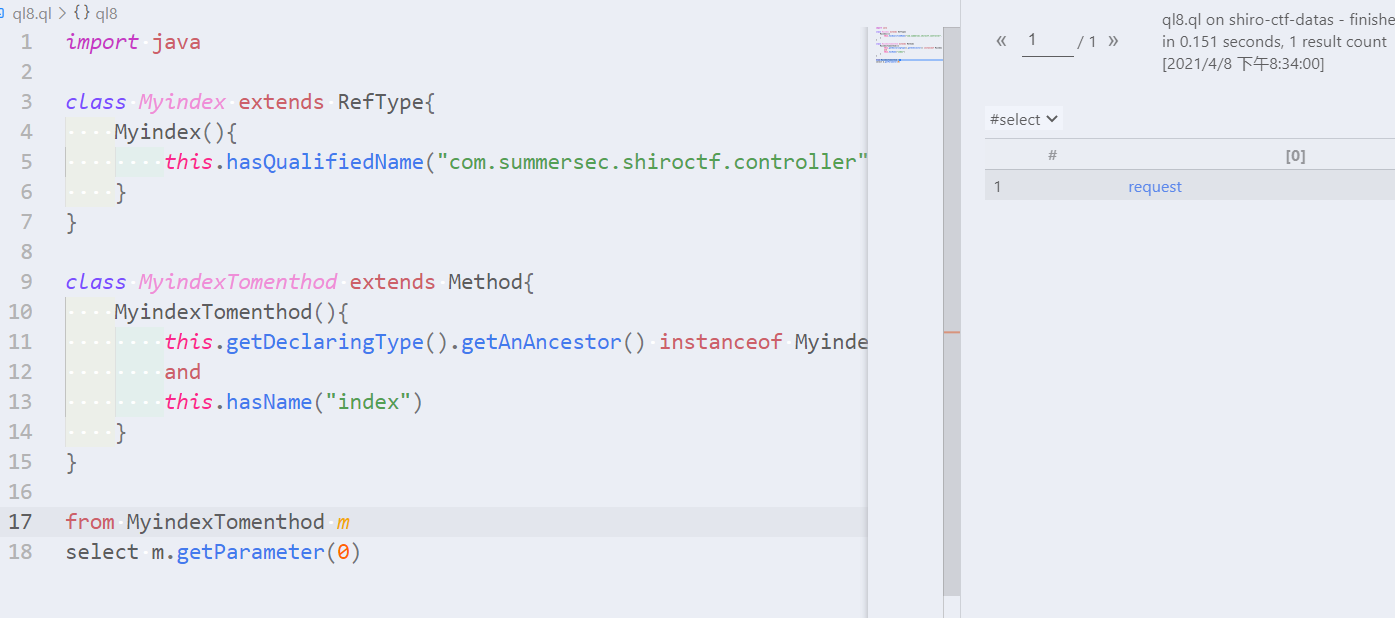
Sink部分
predicate isDes(Expr arg){
exists(MethodAccess des |
des.getMethod().hasName("deserialize")
and
arg = des.getArgument(0)
)
}
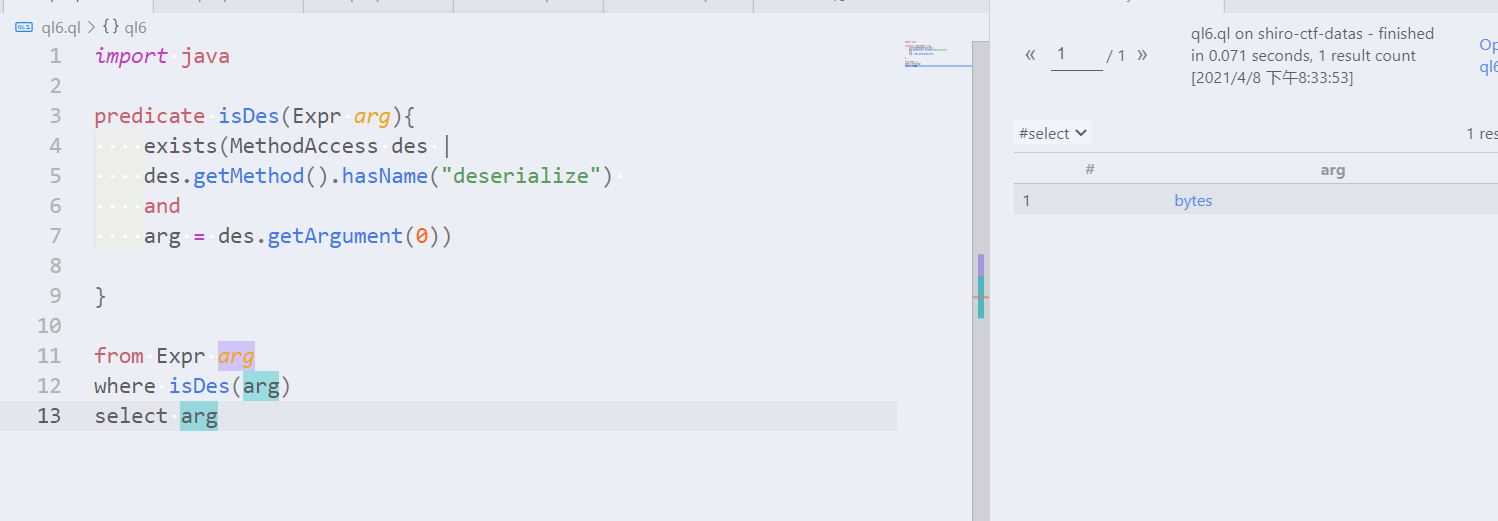
source部分可以查到request,sink部分可以查到bytes。
全局数据流模板
/**
* @name Unsafe shiro deserialization
* @kind problem
* @id java/unsafe-deserialization
*/
import java
import semmle.code.java.dataflow.DataFlow
// TODO add previous class and predicate definitions here
class ShiroUnsafeDeserializationConfig extends DataFlow::Configuration {
ShiroUnsafeDeserializationConfig() { this = "ShiroUnsafeDeserializationConfig" }
override predicate isSource(DataFlow::Node source) {
exists(/** TODO fill me in **/ |
source.asParameter() = /** TODO fill me in **/
)
}
override predicate isSink(DataFlow::Node sink) {
exists(/** TODO fill me in **/ |
/** TODO fill me in **/
sink.asExpr() = /** TODO fill me in **/
)
}
}
from ShiroUnsafeDeserializationConfig config, DataFlow::Node source, DataFlow::Node sink
where config.hasFlow(source, sink)
select sink, "Unsafe Shiro deserialization"
- isSource() 定义了数据可能从哪里流出。
- isSink()定义了数据可能流向的地方。
第一次尝试
CodeQL的注释部分是对查询结果有影响的,@kind关键词将problem转换为 path -problem告诉CodeQL工具将这个查询的结果解释为路径结果。
第一次完整QL代码:
/**
* @name Unsafe shiro deserialization
* @kind path-problem
* @id java/unsafe-deserialization
*/
import java
import semmle.code.java.dataflow.DataFlow
import semmle.code.java.dataflow.TaintTracking
predicate isDes(Expr arg){
exists(MethodAccess des |
des.getMethod().hasName("deserialize")
and
arg = des.getArgument(0))
}
class Myindex extends RefType{
Myindex(){
this.hasQualifiedName("com.summersec.shiroctf.controller", "IndexController")
}
}
class MyindexTomenthod extends Method{
MyindexTomenthod(){
this.getDeclaringType().getAnAncestor() instanceof Myindex
and
this.hasName("index")
}
}
class ShiroUnsafeDeserializationConfig extends TaintTracking::Configuration {
ShiroUnsafeDeserializationConfig() {
this = "ShiroUnsafeDeserializationConfig"
}
override predicate isSource(DataFlow::Node source) {
exists(MyindexTomenthod m |
// m.
source.asParameter() = m.getParameter(0)
)
}
override predicate isSink(DataFlow::Node sink) {
exists(Expr arg|
isDes(arg) and
sink.asExpr() = arg /* bytes */
)
}
}
from ShiroUnsafeDeserializationConfig config, DataFlow::PathNode source, DataFlow::PathNode sink
where config.hasFlowPath(source, sink)
select sink, source, sink, "Unsafe Shiro deserialization"
查询时报错:
Exception during results interpretation: Interpreting query results failed: A fatal error occurred: Could not process query metadata.
Error was: Expected result pattern(s) are not present for query kind "path-problem": Expected between two and four result patterns. [INVALID_RESULT_PATTERNS]
[2021-04-06 15:53:16] Exception caught at top level: Could not process query metadata.
Error was: Expected result pattern(s) are not present for query kind "path-problem": Expected between two and four result patterns. [INVALID_RESULT_PATTERNS]
com.semmle.cli2.bqrs.InterpretCommand.executeSubcommand(InterpretCommand.java:123)
com.semmle.cli2.picocli.SubcommandCommon.executeWithParent(SubcommandCommon.java:414)
com.semmle.cli2.execute.CliServerCommand.lambda$executeSubcommand$0(CliServerCommand.java:67)
com.semmle.cli2.picocli.SubcommandMaker.runMain(SubcommandMaker.java:201)
com.semmle.cli2.execute.CliServerCommand.executeSubcommand(CliServerCommand.java:67)
com.semmle.cli2.picocli.SubcommandCommon.call(SubcommandCommon.java:430)
com.semmle.cli2.picocli.SubcommandMaker.runMain(SubcommandMaker.java:201)
com.semmle.cli2.picocli.SubcommandMaker.runMain(SubcommandMaker.java:209)
com.semmle.cli2.CodeQL.main(CodeQL.java:91)
. Will show raw results instead.
当时询问了几个大佬,没解决之后,去GitHub实验室的Discussion去提问老外帮忙解决的。Discussion332 大致意思时导入import DataFlow::PathGraph而不是import semmle.code.java.dataflow.TaintTracking

第二次尝试
/**
* @name Unsafe shiro deserialization
* @kind path-problem
* @id java/unsafe-deserialization
*/
import java
import semmle.code.java.dataflow.DataFlow
//import semmle.code.java.dataflow.TaintTracking
import DataFlow::PathGraph
predicate isDes(Expr arg){
exists(MethodAccess des |
des.getMethod().hasName("deserialize")
and
arg = des.getArgument(0))
}
class Myindex extends RefType{
Myindex(){
this.hasQualifiedName("com.summersec.shiroctf.controller", "IndexController")
}
}
class MyindexTomenthod extends Method{
MyindexTomenthod(){
this.getDeclaringType().getAnAncestor() instanceof Myindex
and
this.hasName("index")
}
}
class ShiroUnsafeDeserializationConfig extends TaintTracking::Configuration {
ShiroUnsafeDeserializationConfig() {
this = "ShiroUnsafeDeserializationConfig"
}
override predicate isSource(DataFlow::Node source) {
exists(MyindexTomenthod m |
// m.
source.asParameter() = m.getParameter(0)
)
}
override predicate isSink(DataFlow::Node sink) {
exists(Expr arg|
isDes(arg) and
sink.asExpr() = arg /* bytes */
)
}
}
from ShiroUnsafeDeserializationConfig config, DataFlow::PathNode source, DataFlow::PathNode sink
where config.hasFlowPath(source, sink)
select sink, source, sink, "Unsafe Shiro deserialization"
第二次尝试并没有任何报错,但没有任何结果,遗憾收场。
第三次尝试
第二次尝试之后,我把全部代码逻辑在脑子进行无数次演算,不断的推敲逻辑是否可行。实在没办法之后咨询了某度大佬之后,师傅建议使用RemoteFlowSource,在翻开博客之后成功解决。后期大佬解释了RemoteFlowSource的作用,该类考虑了很多种用户输入数据的情况。
/**
* @name Unsafe shiro deserialization
* @kind path-problem
* @id java/unsafe-shiro-deserialization
*/
import java
import semmle.code.java.dataflow.FlowSources
import DataFlow::PathGraph
predicate isDes(Expr arg){
exists(MethodAccess des |
des.getMethod().hasName("deserialize")
and
arg = des.getArgument(0)
)
}
class ShiroUnsafeDeserializationConfig extends TaintTracking::Configuration {
ShiroUnsafeDeserializationConfig() {
this = "StrutsUnsafeDeserializationConfig"
}
override predicate isSource(DataFlow::Node source) {
source instanceof RemoteFlowSource
}
override predicate isSink(DataFlow::Node sink) {
exists(Expr arg|
isDes(arg) and
sink.asExpr() = arg /* bytes */
)
}
}
from ShiroUnsafeDeserializationConfig config, DataFlow::PathNode source, DataFlow::PathNode sink
where config.hasFlowPath(source, sink)
select sink.getNode(), source, sink, "Unsafe shiro deserialization" ,source.getNode(), "this user input"
// select sink, source, sink, "Unsafe shiro deserialization" ,source, "this user input"
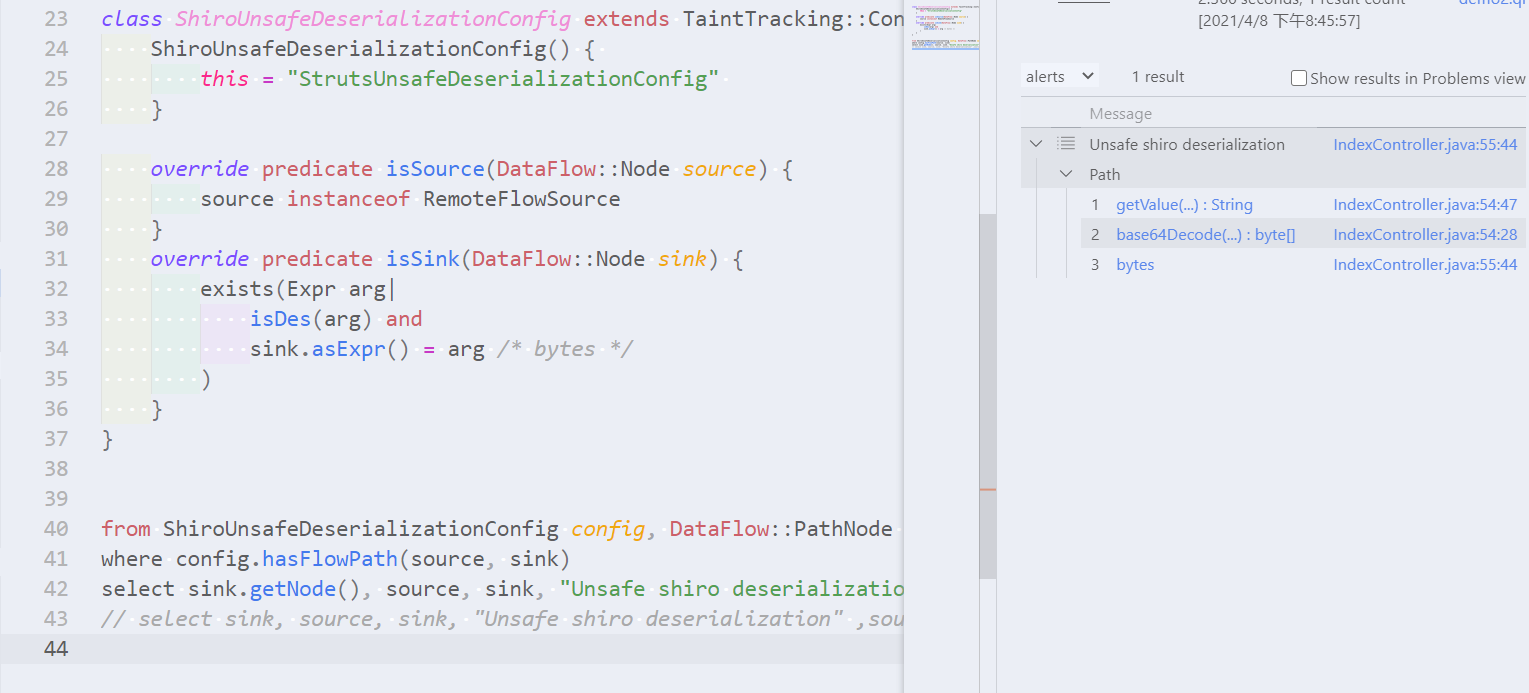
其实查到这里并没有达到我心理的预期,预期结果是将:request->cookies->cookie->bytes整个路径查询出来。于是我又去Discussion去提问了,Disuccsion334 ,起初我没看懂老外的意思,老外也没有懂我的意思,语言的障碍,下面是对话内容:

老外给的答案,大致意思这样子已经很好,没有必要去追求。实在想的话,得把source部分改了并且增加谓词isAdditionTaintStep。

补充
目前找到了可控用户输入数据到反序列化整个链,但如何去利用呢?前面我发现LogHandler类是调用了Tools#exeCmd方法,利用调用该类此特性就可以完成Exploit的编写。利用方式参考一道shiro反序列化题目引发的思考 ,这里就不在赘述。
LogHandler源码:
private Object target;
private String readLog = "tail accessLog.txt";
private String writeLog = "echo /test >> accessLog.txt";
public LogHandler() {
}
public LogHandler(Object target) {
this.target = target;
}
@Override
public Object invoke(Object proxy, Method method, Object[] args) throws Throwable {
Tools.exeCmd(this.writeLog.replaceAll("/test", (String)args[0]));
return method.invoke(this.target, args);
}
@Override
public String toString() {
return Tools.exeCmd(this.readLog);
}
总结
如何找到Source和定位Sink是本文的重点,在CodeQL规则中也是一个重点。但让规则更加完美处理中间额外污染步骤AdditionalTainStep也很重要,本文对此并没有涉及。对于小白来说,可能这篇文章还是有点难度,我已经尽可能写小白化了。对于学过CodeQL入门的童鞋应该是刚刚好。
参考
https://xz.aliyun.com/t/7789#toc-0
https://summersec.github.io/2021/03/28/CodeQL%20workshop%20for%20Java%20Unsafe%20deserialization%20in%20Apache%20Struts/
https://xz.aliyun.com/t/7789#toc-8
https://0range228.github.io/%E6%B1%A1%E7%82%B9%E5%88%86%E6%9E%90%E7%AE%80%E5%8D%95%E4%BB%8B%E7%BB%8D/
https://github.com/github/securitylab/discussions/334
https://github.com/haby0/mark/blob/master/articles/2021/CodeQL-%E6%95%B0%E6%8D%AE%E6%B5%81%E5%9C%A8Java%E4%B8%AD%E7%9A%84%E4%BD%BF%E7%94%A8.md